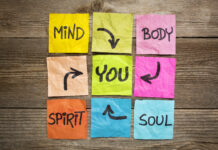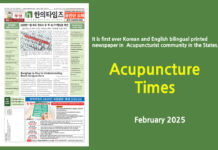Written By Jun Heo(許浚, 1539~1615), Translated by Namil Kim, Wung Seok Cha et al., Published by Ministry of Health & Welfare (Korea)
01 The Shape of the Kidneys 腎形象 신의 형상
- ① There are two kidneys. The shape resembles a red bean. They face each other in a bended position and are attached to the muscles of the back. The outside is covered with oil and black in color. The inside is white. It governs the storage of essence.
- ② There are two kidneys. Each weighs nine nyang. Some say the two kidneys weigh 1 geun 2 nyang. The left kidney belongs to Water and the right kidney to Fire. Men mainly use the left kidney on this basis and women mainly use the right kidney on this basis.
- ③ The shape of the kidney resembles a red bean. They face each other in a ring-like bended position and are attached to both sides of the membrane of the spinal vertebra. The kidney is white inside and violet outside. The kidney system on each side corresponds to each other and moves down. They go upward to be connected to the heart system. This refers to ‘Water of Gam (坎水) is in north and Fire of Li trigram (離火) is in south, so Water and Fire correspond to each other.’
02 There Are Two Kidneys 腎臟有二 신장은 2개가 있다
- ① Why do the kidneys have two organs while others only have one? People commonly say there are two kidneys, but it is actually one. The left one is the kidney and the right one is the life gate. The life gate is where essence spirit stays and is related to original qi. Men store essence here and women’s are connected to the uterus. Therefore, there is only one kidney.
- ② The life gate is not a real viscus like the triple energizer is not a real bowel.
03 Areas of the Kidneys 腎部位 신의 부위
- ① The kidneys are on the opposite side of the umbilicus and correspond to the lower back.
- ② The lower back is where the condition of the kidneys is manifested.
- ③ The kidneys are metaphorized as a faithful woman. They are located in the lower back and number two.
- ④ GB25 is the alarm point of the kidneys. It is located next to lumbar vertebra, 1 chon 8 pun below the rib. BL23 is below the 14th vertebra. And GC4 is below the 14th vertebra, opposite to the umbilicus. These are the areas of the kidneys.
- ⑤ The life gate system is the pericardium collateral. The meridian is hand reverting yin, and the bowel is the triple energizer. The location is the pit of the stomach. It starts from the upper side of the diaphragm and moves down obliquely and then is attached to the diaphragm. The heart is placed here, covered with yellowish fat. Outside the fat, there is a narrow fascia connected to the lungs and the heart. This is the pericardium collateral.
04 Time and Day When the Kidneys Govern 腎主時日 신이 주관하는 시간과 날짜
- ① The kidneys govern winter. They control foot lesser yin and foot greater yang and govern the days of Yim and Gye.
- ② North engenders cold, cold engenders Water, Water engenders salty taste, and salty taste engenders the kidneys.
- ③ The kidneys are lesser yin of yin. They correspond to winter qi.
- ④ The kidneys govern the acceptance of essence from food and water. They are so quiet that turbid qi moves only once from 11:00 p.m to 01:00 a.m.
05 Things Belonging to the Kidneys 腎屬物類 신에 속하는 것들
The kidneys are cold in heaven, Water on earth. They are the Gam trigram (坎卦) in the Book of Changes, and bone in the five bodies. They are the kidneys in the five viscera, and black in the five colors. They are the Wu sound (羽) in the five notes and moaning sound in the five sounds. They are shivering in the five changes and the ear in the five orifices. They are salty taste in the five tastes and fear in the five emotions. The corresponding meridian is foot lesser yin, and the corresponding humor is saliva. The state of the kidneys is manifested in the hair. The corresponding smell is a rotten smell, and the corresponding number is six. The corresponding grain is bean, and the corresponding animal is pig. The corresponding animal group is animals with scales. The corresponding fruit is chestnut and the corresponding vegetable is bean leaves. The corresponding meridian is foot lesser yin.
06 The Size of the Kidneys 腎臟大小 신장의 대소
① The kidneys govern outside, so they enable the person to hear distant sounds. Therefore, observing the ear can determine the characteristic of the kidneys.
② The person with black and dense skin has small kidneys, while the person with rough skin has big kidneys. The person with high-positioned ears has the kidneys on a higher position than normal, and the person with posteriorly-positioned ears has the kidneys on a lower position. Healthy ears mean healthy kidneys, and thin and unhealthy ears mean weak kidneys. Ears that are good-looking and located in front of ST6 mean the normal position of the kidneys. The person who has ears of different heights has kidneys that are tilted to one side.
③ When the kidneys are small, they provide stability and they do not get hurt easily. When the kidneys are big, the person has frequent lower back pain with susceptibility to pathogens. When the kidneys are high, the back and spine are painful, causing the person to be unable to bend or stretch the lower back. When the kidneys are low, the lower back and sacrum may be painful, or the person may have an inguinal hernia. When the kidneys are stable, the person does not experience any pain in the back or lower-back. When the kidneys are weak, the person tends to have wasting-thirst. When the kidneys are in the right place, they do not get hurt easily because the kidneys are harmonious. When the kidneys are tilted, the person’s lower back and sacrum will become painful.
07 Symptoms of Kidney Damage 腎傷證 신상증
- ① Lifting heavy objects, excessive intercourse, and taking a bath after sweating can damage the kidneys.
- ② Sitting down in a damp place for a long time or going into the water against one’s will can damage the kidneys.
08 Symptoms of Kidney Disease 腎病證 신병증
- ① When the pathogen is in the kidneys, the person feels pain in the bones and it becomes a yin impediment. A yin impediment includes these symptoms: inability of pointing out the exact location of pain, abdominal distention, lower back pain, difficulty in defecation, pain around the shoulders, back, neck and nape, and intermittent dizziness.
- ② When a spleen disease is transferred to the kidneys, it is called a hernia with abdominal mass. There is stagnant heat in the lower abdomen and whites come out in urine. This is also called a parasitic disease. Annotation says, “The whites mean that white fluid comes out with urine.”
- ③ When there is kidney heat, the person’s facial complexion becomes black and the teeth dry.
- ④ The person will die within one year when the bones and muscles of the thigh region dry and thin, marrow decreases, movement becomes difficult, and the true visceral pulse is observed. When the true visceral pulse is observed, the person will die soon. Annotation says, “This refers to the kidneys. The person will die within 365 days.”
- ⑤ External symptoms of a kidney disease are black face, too much fear, and frequent yawning. The internal symptoms are stirring qi under the umbilicus that is hard and painful to pressure. When the kidneys are diseased, the person’s qi flows upward and there is a pulling pain in the lower abdomen. Also, the person suffers from diarrhea and tenesmus. The person also feels cold starting from the shins.
09 Deficiency and Excess of the Kidneys 腎病虛實 신병의 허실
- ① When the kidneys are deficient, the person’s body becomes cold; when the kidneys are excessive, the abdomen swells.
- ② When the kidneys are excessive, the person experiences the following symptoms: distention of the abdomen, swelling of the shins, coughing with dyspnea, heaviness of the body, night sweating, and an aversion to wind. When the kidneys are deficient, there will be chest pain, abdominal pain, cold hands and feet, and a loss of happiness.
- ③ When the kidneys are deficient, the chest becomes empty, the person feels hungry and tends to get fearful.






































